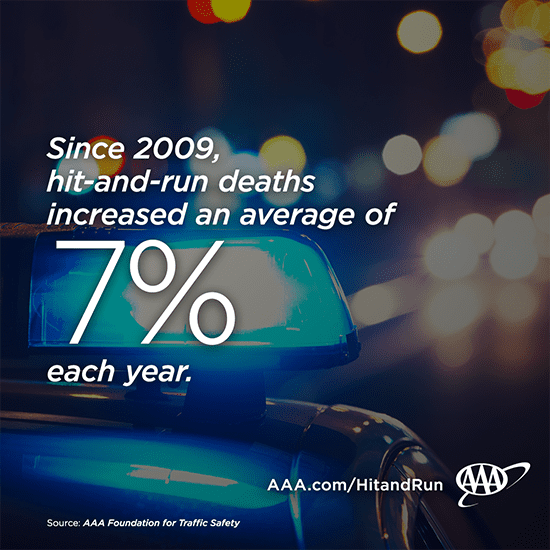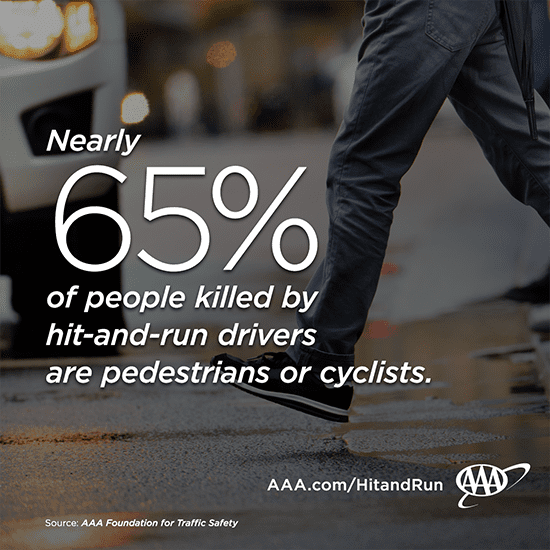A hit-and-run crash occurs every 43 seconds on U.S. roadways; 2,049 fatalities in 2016
BOISE – (April 26, 2018) – New research by the AAA Foundation for Traffic Safety indicates that the number of hit-and-run crashes and fatalities nationwide is rising at an historic rate. In 2016 – the most recent data available – there were 1,980 fatal hit-and-run crashes that resulted in 2,049 fatalities. That’s the highest annual number since 1975, when the National Highway Traffic Safety Administration began compiling statistics on fatal motor vehicle crashes.
“Hit-and-run crashes in the United States are trending in the wrong direction,” said Dr. David Yang, executive director of the AAA Foundation for Traffic Safety. “Our analysis shows that hit-and-run crashes are a growing traffic safety challenge.” A hit-and-run crash occurs every 43 seconds on a U.S. roadway.
AAA’s research shows that the number of hit-and-run fatalities has increased by an average of 7 percent per year since 2009. Nearly two-thirds of those killed are bicyclists and pedestrians.


“There are any number of reasons that some drivers may be tempted to flee the scene of an accident, including criminal activity such as driving under the influence of drugs or alcohol, or without a valid license,” says AAA Idaho spokesman Matthew Conde. “Such an attempt at self-preservation is completely irresponsible, and can carry serious consequences for innocent people.”
Experts highlight the importance of the ‘golden hour’ – the medical treatment a victim receives in the first hour following a collision can significantly reduce the risk of traumatic injury and death.
An average of 682,000 hit-and-run crashes occurred per year from 2005-2014, but there were more than 737,000 in 2015. While 1 in 5 pedestrian deaths involves a hit-and-run crash, just one percent of vehicle driver deaths are attributed to hit-and-run. More hit-and-run crashes happen between midnight and 4 a.m. than during any other time of day. Studies have shown that drivers who flee are between two and nine times more likely to have been intoxicated at the time of the crash.
Drivers in hit-and-run fatalities tend to be young males with a prior history of impaired driving or driving without a valid license.
In Idaho, there were nine hit-and-run crashes involving fatalities in 2016, the most in more than a decade. However, the majority of Idaho’s hit-and-run drivers are later identified. From 1998-2007, Idaho law enforcement eventually identified 86 percent of offenders who left the scene, giving the Gem State the second-highest ranking in the nation.
“The message is very clear – do the right thing and stay at the scene of the accident,” Conde said. The penalties are much more severe if people try to avoid accountability for their actions.”
Idaho state law requires drivers to remain on the scene, provide complete and accurate information (including driver license number and proof of liability insurance), render first aid and if necessary, transport the injured, and notify law enforcement as soon as possible. Failure to comply can lead to jail time, hefty fines, and a year of driver license revocation.
AAA invites drivers to remember their ABC’s after a crash:
Assist the injured. Check for injured people and call 911.
Be visible. Make the scene visible to approaching drivers. Use flares, reflectors and hazard lights to provide an early warning to others to slow down. Where possible, move vehicles to a safe location like the shoulder of the road or a nearby parking lot.
Communicate. Call the police and file a report. If the police don’t come to the scene, exchange information with the other drivers, collect contact information from witnesses, and file a police report as soon as possible.
“What’s often lost in these discussions is that the most vulnerable groups are bicyclists and pedestrians,” Conde said. “Always wear bright, reflective clothing to increase your visibility to motorists. Don’t count on others to keep you safe – you should be your own best advocate when it comes to making sure that you get home safely.”

